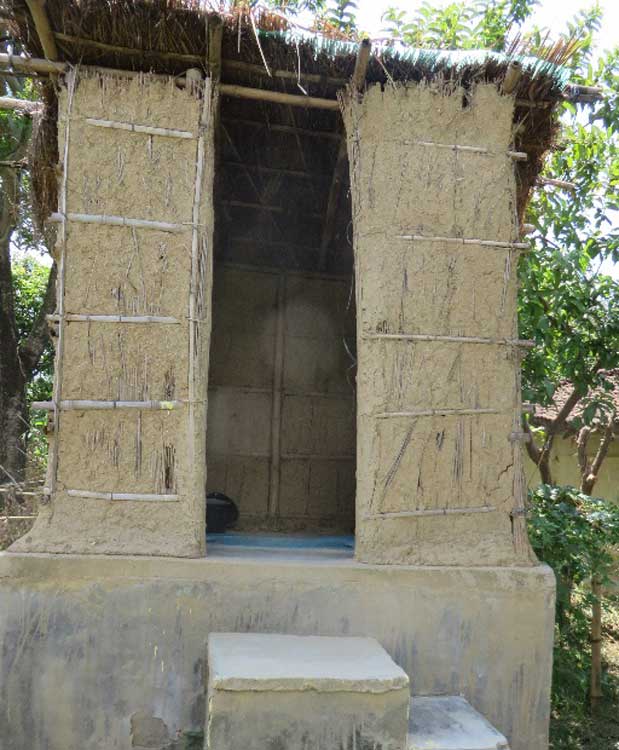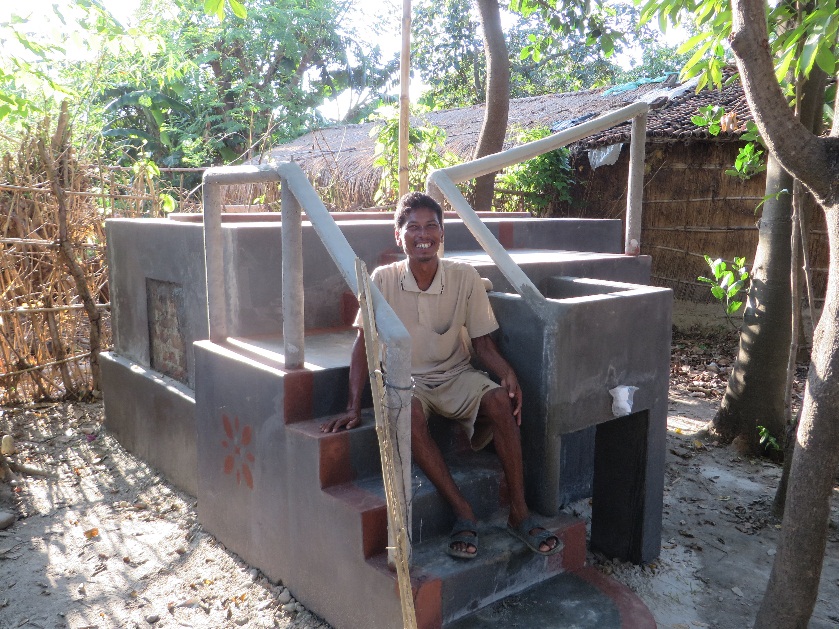By Avash Pandey and Anjal Prakash, ICIMOD
The Ganges River originates in the Himalayan region, passes through rough terrains, on through the plains and finally drains into the Indian Ocean at the Bay of Bengal. It has a total length 2,510 km or 1,560 miles. Its basin area (1.09 million km2) spreads across India (79%), Nepal (13%), Bangladesh (4%) and China (4%) (The impacts of water infrastructure and climate change on the hydrology of the Upper Ganges River Basin). The Ganges passes through the states of Uttarakhand, Uttar Pradesh, Bihar, Jharkhand and West Bengal. The major tributaries of the Ganges are the Karnali, Mahakali, Gandak, Koshi (Kosi), Ghaghra, Damodar, Yamuna, Son, Mahananda and Chambal. The riparian countries of the region are highly dependent on glacier-fed rivers such as the Ganges, whose basin has the highest population density in the world. Indeed, quite a few ancient civilizations were known to have settled around the Ganges River.
On the banks of the river Gandak in India lies the West Champaran district, which was carved out of the old Champaran District in the year 1972 as a result of a re-organisation of the district in the state of Bihar, India. The name Champaran is a degenerate form of Champaka Aranya, a Sanskrit name that dates back to the time when the district was a tract of the forest of Champa (magnolia) trees and was the abode of solitary ascetics. Of late, the district is largely known for floods. Floods/flash floods, of varying intensities, occur here almost every year. Depending on the intensity, the coverage area of the floods also changes. The year 2007 saw the most number of blocks (16) getting affected by floods. They affected over 0.2 million people, and as many as 223 villages were surrounded by water. The year 2010 saw 12 blocks affected by floods, even though the damage not as much as one would expect given the area the water covered. The Government of Bihar’s (GoB) Hazard, Vulnerability and Capacity Assessment report of 2013 identifies floods as major disasters that occur every year. The report recognises the following: ‘heavy rains in the hilly terrains of Nepal flashes down as river streams into the plains of West Champaran of Bihar causing flash floods in Northern blocks of the district. This overflow of water out of its river course into the agricultural fields or into the villages is also attributed to another factor, i.e., deposition of silt on the river bed. Silt – mud or small rocks – that river carries is created by rubbing of river with the hill stones and as it flows downstream, it continues depositing it into the plains. This over the years has decreased the depth of the river bed and as a result, a lot of river beds are almost level with the land. This becomes the cause of floods even with marginal river water rise’.
Climate variability is recognised as one of the major reasons that is causing heavy precipitation upstream in Nepal, leading to increased frequency of floods in the plains of Bihar. The impacts of climate change are being manifested locally as a consequence of extreme and more frequent weather patterns. This is apart from various other factors that are creating flood-like situations in West Champaran. One of the major impacts that frequent floods and flash floods have is on sanitation. The census of India (2011) shows that Bihar has only 18.6% sanitation coverage, thus ranking it in the bottom four amongst all the states in India. The situation in West Champaran reflects this state of affairs. The sanitation problem gets exacerbated during floods, when people defecate in the flooded areas and then are forced to drink the same water if potable drinking water is not available. Understanding the needs of the communities here, Megh Pyne Abhiyan (MPA), a network of NGOs working in Bihar, has been promoting eco-sanitation. ICIMOD is partnering with MPA to work on the Gandak River basin as part of the HI-AWARE initiative.
 Photo 1: An eco-san toilet with a high platform
Photo 1: An eco-san toilet with a high platform
On a recent field visit, a team from ICIMOD went to Kairi, Domat Panchayat, Gaunaha Block, West Champaran, Bihar, India. The village lies on the banks of the Pandai River, just a few kilometres away from the Nepali border. The village is largely inhabited by Tharus. When we reached the village, we asked the people if there were any toilets around; the villagers pointed to an open field. Open defecation is quite common in remote areas in Bihar. Even the few educated inhabitants in the village did not have toilets in their houses, and there were a few cemented houses that did not have toilets as well. The ICIMOD team learned that generations had lived in this village without having access to proper sanitation, and that was why MPA was undertaking its ecological-sanitation (eco-san) toilet project in the village.
The eco-san toilet is an adaptive measure for climate change, providing resilience and maintaining sanitation and hygiene. The communities in this area of Bihar are vulnerable to flash floods, and the construction of a high- platform eco-san toilet allows the villagers to use the toilet even during floods and later when water gets logged (Photo 1). The excreta produced by the families using these toilets can be applied to their farms, thus reducing the demand for artificial fertilisers. If more people were to use such toilets, the use of phosphorus, a finite resource used in the manufacture of fertilisers, could decrease. The total carbon dioxide emission amount that can be saved with the use of an eco-san system is about 107 kg/person/year (Sustainability and Climate Change aspects of Ecosan Toilet : Nepal prospective). The eco-san toilet produces less GHG, and it also uses less water than the traditional flush-system toilets. It also stops the spread of diseases, unlike with septic tanks, which get washed away or fill up during floods.
The eco-san toilet model was set up by MPA in Purwi Tola, Rupwalliya panchayat of Gaunaha Block. Upon hearing about it, villagers from as far as Kairi Village had come to examine it, upon which the villagers exchanged ideas and knowledge about the toilet. The villagers make a living out of agriculture, so they could not ignore the advantages that eco-san toilets had, especially because the toilets were a source of natural fertilisers. A farmer in Purwi Tola said that after using the fertiliser from the eco-san toilet for a couple of years, his barren land, which had failed to produce any crops earlier, started producing corn. Encouraged by this and other and examples of success, other villages had started building eco-san toilets too.
 Photo 2: Mr Rabinder Mahato sitting on the foundation of his eco-san toilet.
Photo 2: Mr Rabinder Mahato sitting on the foundation of his eco-san toilet.
In Kairi Village, we met with Mr Rabinder Mahato, a local resident whose family has been residing here for two generations. Mr Mahato is a farmer and owns two acres of land. He has nine family members, including his mother, four sons and two daughters. MPA visited his village and mentioned the benefits of eco-san toilets; he later visited Rupwalliya and subsequently got inspired to build an eco-san toilet for his family. Earlier, the Mahato household had been defecating in the open, and Mr Mahato says that he can’t wait for his toilet to get ready (Photo 1); he has spent a bit more than INR 18,000 on the toilet. The amount is high given the financial situation of the family, but he does not want to compromise when it comes to sanitation now. The toilet has been a model for the whole village, with its stable construction and added functions such as it facility for harvesting rainwater, which can be used for toilet purposes. We were excited to see the construction of eco-san toilets in a few households, and the priority that was being given to building toilets. To discourage open defecation, the GoB has been providing incentives for the villagers who are building toilets. In addition, the GoB’s policy of not sanctioning the houses, under the Indira Awas Yojana, for households that do not have a provision for a toilet encourages the construction of toilets. The villagers, for their part, seem to know about the benefits of the eco-san toilet, as we could see the quick pace in they were being built. It is perhaps safe to conclude that with a little bit of technical help from MPA along with Water Action and support from the GoB in rural areas such as Kairi, better sanitation and hygiene for villagers can be accomplished.
